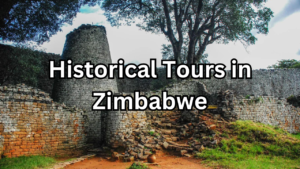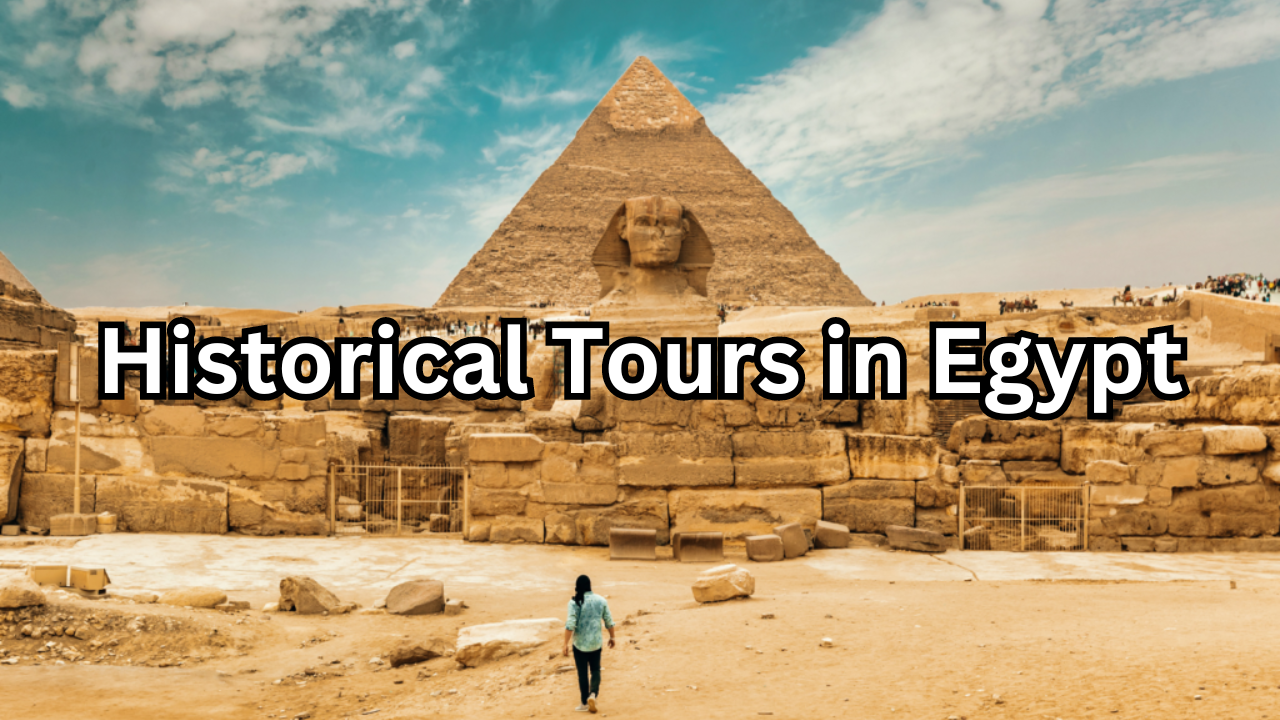
Table of Contents
Introduction to Historical Tours in Egypt
Egypt, an ancient cradle of civilization nestled along the Nile River, beckons travelers from across the globe with its timeless allure. Steeped in a legacy that spans over 5,000 years, Egypt is not just a country but a living museum where each monument, temple, and artifact tells a story of grandeur and mystery. Historical tours in Egypt promise an immersive journey through time, offering visitors a chance to witness firsthand the wonders of an ancient world.
What Makes Egypt a Prime Destination for Historical Tours?
Egypt’s allure as a prime destination for historical tours is unrivaled, owing to its treasure trove of archaeological wonders and cultural heritage. From the magnificent pyramids of Giza, icons of human achievement, to the enigmatic Sphinx standing guard over millennia-old secrets, Egypt captivates with its monumental relics of the past. The country’s strategic location at the crossroads of Africa, Asia, and Europe facilitated the exchange of ideas and cultures, shaping civilizations that left an indelible mark on history.
Overview of Egypt’s Rich Historical Significance
Egypt’s rich historical significance extends beyond its iconic monuments to encompass a tapestry of ancient civilizations and empires. From the majestic temples of Luxor and Karnak, testament to the grandeur of the New Kingdom, to the royal tombs of the Valley of the Kings, where pharaohs sought eternal life, every corner of Egypt bears witness to a storied past. The Nile River, the lifeblood of ancient Egypt, nurtured a thriving civilization whose advancements in architecture, art, and governance continue to intrigue and inspire.
Major Ancient Egyptian Sites
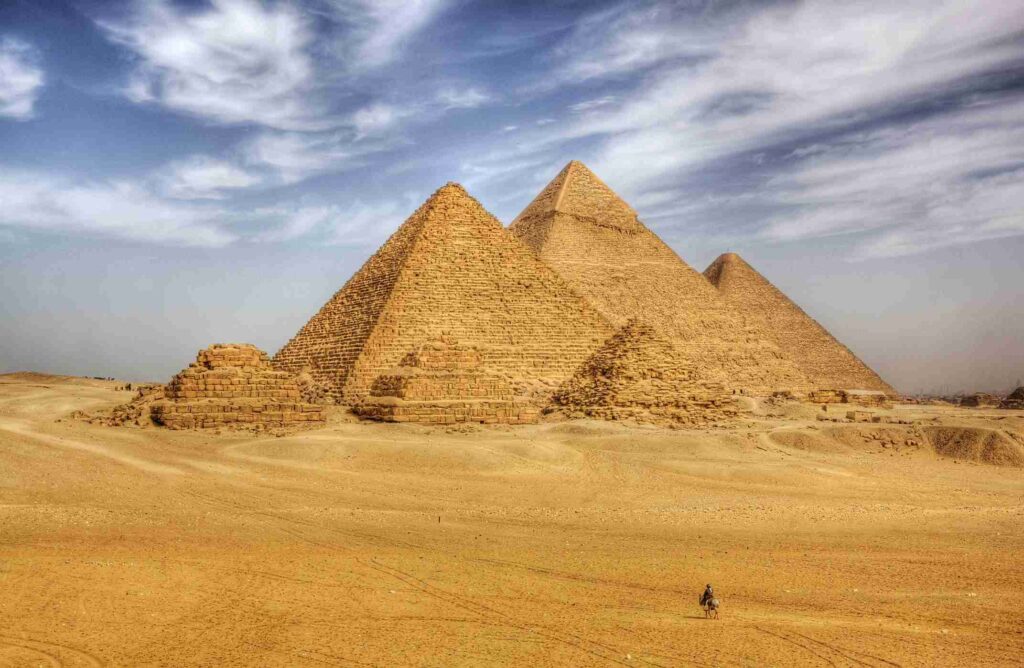
The Pyramids of Giza
History and Significance
The Pyramids of Giza, the last surviving wonders of the ancient world, stand as an enduring testament to the ingenuity and ambition of ancient Egyptian civilization. Constructed over a span of several decades during the 26th century BCE, these monumental structures were built as royal tombs for three pharaohs: Khufu, Khafre, and Menkaure.
Each pyramid was meticulously planned and constructed using millions of limestone blocks, weighing several tons each. The Great Pyramid of Giza, built for Pharaoh Khufu, remains the largest and most awe-inspiring, standing at a height of over 140 meters when completed, making it the tallest man-made structure for over 3,800 years.
Architectural Marvels
The architectural feats achieved at Giza are staggering even by modern standards. The precision with which the pyramids were aligned to the cardinal points of the compass reflects the Egyptians’ advanced understanding of astronomy and mathematics. The construction techniques, including the use of ramps, sledges, and lever systems to transport and position the massive stone blocks, demonstrate a mastery of engineering unparalleled in their time.
Beyond their monumental scale and technical prowess, the Pyramids of Giza hold profound cultural and religious significance. Believed to facilitate the pharaoh’s journey to the afterlife, these pyramids were adorned with elaborate mortuary temples, causeways, and smaller satellite pyramids for the pharaoh’s family members and officials, creating vast necropolis complexes that symbolizes eternal life and divine kingship.
Today, the Pyramids of Giza continue to captivate and intrigue visitors from around the world, offering a glimpse into the achievements and beliefs of ancient Egypt while standing as enduring symbols of human ambition and creativity.
The Pyramids of Giza: Ancient Marvels of Egypt
History and Significance
The Pyramids of Giza stand as enduring symbols of ancient Egypt’s architectural prowess and cultural legacy. Built over 4,500 years ago during the Old Kingdom, these monumental structures were commissioned by pharaohs as royal tombs, designed to safeguard their mummies and treasures for eternity. The Great Pyramid, constructed for Pharaoh Khufu, is the largest and most famous among them, reflecting the power and ambition of Egypt’s rulers in antiquity.
Architectural Marvels
The Pyramids of Giza are marvels of ancient engineering, each meticulously constructed with millions of limestone blocks, weighing several tons apiece. The precision and scale of their construction continue to astound historians and engineers alike, showcasing the advanced capabilities of ancient Egyptian builders. The pyramids’ smooth, angled sides were originally covered in gleaming white limestone casing stones, creating a dazzling sight that would have reflected the sun’s rays across the desert landscape.
Inside the Great Pyramid
Venturing inside the Great Pyramid offers a glimpse into the pharaoh’s quest for immortality. The interior chambers, including the King’s Chamber and the Grand Gallery, reveal the pyramid’s inner structure and the elaborate burial arrangements intended to accompany the pharaoh into the afterlife. Despite centuries of exploration and plundering by tomb raiders, the Great Pyramid continues to captivate with its mysterious passageways and architectural precision, offering visitors a rare opportunity to step back in time and ponder the mysteries of ancient Egypt.
The Sphinx: Guardian of Ancient Egypt
Mythology and Symbolism
The Sphinx, with the body of a lion and the head of a human, embodies the fusion of strength and intellect in Egyptian mythology. Carved during the reign of Pharaoh Khafre around 2500 BCE, the Sphinx is believed to represent the king’s divine authority and his role as a protector of the pyramids and the nearby necropolis. In ancient Egyptian belief, sphinxes were associated with solar deities and served as guardians, warding off evil spirits and ensuring the eternal protection of sacred sites.
Restoration Efforts
Over millennia, the Sphinx has weathered the elements and human intervention, facing erosion and structural challenges. In modern times, extensive restoration efforts have been undertaken to preserve this iconic monument. Conservation projects have included stabilizing the Sphinx’s limestone body, reinforcing its weakened structure, and addressing damage caused by environmental factors and past restorations. These efforts, supported by archaeological research and technological advancements, aim to safeguard the Sphinx for future generations while respecting its historical and cultural significance.
Luxor Temple Complex: A Timeless Marvel of Ancient Egypt
Overview of the Complex
Located on the east bank of the Nile River in modern-day Luxor, the Luxor Temple Complex is a testament to the grandeur and religious significance of ancient Thebes, the capital of Egypt during the New Kingdom period. Constructed over several centuries, from approximately 1400 BCE to 1200 BCE, the temple served as a center of religious worship and royal ceremonies dedicated primarily to the god Amun.
Avenue of Sphinxes, Obelisks
Avenue of Sphinxes: The approach to Luxor Temple was once flanked by an impressive Avenue of Sphinxes, stretching over a mile and linking the temple with the Karnak Temple Complex to the north. These sphinxes, with the bodies of lions and heads of rams, symbolized the god Amun and served as a ceremonial pathway for religious processions and pilgrims.
Obelisks: Within the Luxor Temple Complex, towering obelisks stand as symbols of divine power and royal authority. Originally erected in pairs, these monolithic structures were crafted from single blocks of pink granite and adorned with intricate hieroglyphs glorifying the achievements and piety of the pharaohs. One of the most famous obelisks from Luxor Temple now graces the Place de la Concorde in Paris, a testament to Egypt’s enduring influence on global art and architecture.
Valley of the Kings: Where Pharaohs Rest in Splendor
Tombs of Famous Pharaohs
The Valley of the Kings, nestled on the west bank of the Nile near Luxor, is renowned for its collection of elaborately decorated tombs that housed the remains and treasures of Egypt’s most illustrious pharaohs. Built between the 16th and 11th centuries BCE, these tombs were meticulously designed to ensure the safe passage of the deceased pharaoh into the afterlife. Each tomb is a testament to the wealth and power of its occupant, adorned with intricate hieroglyphs, colorful frescoes, and scenes depicting the pharaoh’s journey through the underworld.
Among the most famous tombs is that of Tutankhamun, discovered nearly intact by archaeologist Howard Carter in 1922. This discovery, with its treasures including the iconic golden mask, offered unprecedented insight into royal burial practices and sparked worldwide fascination with ancient Egypt. Other notable tombs include those of Ramses II, Seti I, and Thutmose III, each revealing unique aspects of royal life and religious beliefs during their respective reigns.
Discovery and Exploration
The Valley of the Kings has been a site of continuous exploration and discovery since antiquity. While many tombs were looted in ancient times, some remained hidden beneath layers of debris and shifting sands, awaiting rediscovery in the modern era. The systematic excavation of the valley began in the 19th century, revealing a labyrinth of interconnected chambers and corridors that extended deep into the bedrock. Archaeologists and Egyptologists have meticulously documented and studied these tombs, uncovering invaluable artifacts and insights into ancient Egyptian funerary practices and religious beliefs.
Today, the Valley of the Kings stands as a testament to the enduring legacy of Egypt’s pharaohs, offering visitors a glimpse into the opulence and spirituality that defined one of history’s greatest civilizations. Protected as a UNESCO World Heritage Site, it continues to inspire awe and curiosity, inviting travelers from around the world to explore its ancient mysteries and pay homage to the rulers who sought immortality in the embrace of the desert hills.
Museums and Exhibitions
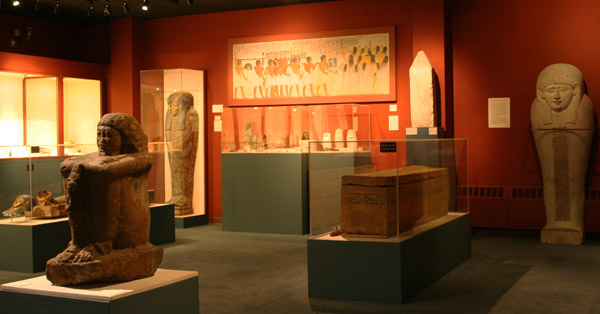
Egyptian Museum (Cairo)
Treasures of Tutankhamun
The Egyptian Museum in Cairo stands as a repository of Egypt’s rich cultural heritage, housing an extensive collection of artifacts spanning thousands of years of history. Among its most celebrated treasures are those from the tomb of Tutankhamun, the boy pharaoh who ruled during the 18th dynasty. Discovered virtually intact in 1922 by Howard Carter in the Valley of the Kings, Tutankhamun’s tomb contained a dazzling array of artifacts meant to accompany him into the afterlife. The centerpiece of the collection is the iconic golden funerary mask of Tutankhamun, crafted from solid gold and adorned with inlaid precious stones. This mask, with its serene expression and intricate detailing, has become synonymous with ancient Egyptian artistry and is considered one of the museum’s most prized possessions. Other notable artifacts from Tutankhamun’s tomb include elaborate jewelry, ceremonial weapons, chariots, and everyday objects meticulously crafted from gold, silver, and precious gemstones.
Other Notable Artifacts
Beyond Tutankhamun’s treasures, the Egyptian Museum boasts an impressive array of artifacts that offer insights into various aspects of ancient Egyptian life and culture. These include statues of pharaohs and deities, intricately carved sarcophagi, papyrus scrolls detailing religious texts and daily life, and exquisite examples of pottery and jewelry. The museum’s collections span periods from the prehistoric era to the Greco-Roman period, showcasing the evolution of Egyptian art, technology, and belief systems over millennia. Among the museum’s highlights are the Royal Mummy Room, where visitors can view the mummified remains of some of Egypt’s most famous rulers, and the Amarna Collection, featuring artifacts from the city of Akhetaten founded by Pharaoh Akhenaten. Each artifact in the Egyptian Museum offers a window into the ancient world, preserving the legacy of a civilization that continues to captivate and inspire admiration worldwide. Visiting the Egyptian Museum in Cairo is not just a journey through time but a chance to witness firsthand the treasures that have shaped our understanding of ancient Egypt’s enduring legacy. As custodian of one of the world’s most significant collections of Egyptian antiquities, the museum stands as a testament to the craftsmanship, spirituality, and cultural richness of this remarkable civilization.
Nubian Museum (Aswan): Preserving the Heritage of Ancient Nubia
Nubian Culture and Artifacts
The Nubian Museum in Aswan stands as a tribute to the rich cultural heritage of the Nubian people, an ancient civilization that flourished along the banks of the Nile River in what is now southern Egypt and northern Sudan. The museum’s collections span thousands of years, showcasing artifacts that highlight Nubia’s unique artistic traditions, religious beliefs, and societal structures. Nubian art is characterized by its vibrant colors, intricate designs, and symbolic motifs that reflect the region’s close ties to both Egypt and sub-Saharan Africa.
Artifacts on display include pottery, jewelry, tools, and sculptures that provide insights into daily life, craftsmanship, and the spiritual practices of the Nubian people. The museum also houses reconstructed temples and architectural elements from Nubian archaeological sites, offering visitors a glimpse into the grandeur of ancient Nubian architecture and urban planning.
Impact of the Aswan High Dam
The construction of the Aswan High Dam in the 1960s had a profound impact on the Nubian people and their cultural heritage. The dam, built to control the annual flooding of the Nile and generate hydroelectric power, resulted in the flooding of large areas of Nubian land, including ancient archaeological sites and villages. Thousands of Nubians were displaced from their ancestral homes along the Nile’s banks, leading to the loss of cultural continuity and traditional ways of life.
In response to the impending flooding, international efforts were launched to salvage and relocate significant archaeological sites and monuments, such as the temples of Abu Simbel, which were painstakingly dismantled and reassembled on higher ground. The Nubian Museum in Aswan emerged as part of these preservation efforts, serving not only to educate visitors about Nubian history and culture but also to advocate for the preservation of Nubian identity in the face of modern development.
Today, the Nubian Museum stands as a beacon of cultural preservation and education, celebrating the resilience and creativity of the Nubian people while raising awareness about the challenges they have faced. By showcasing Nubia’s rich artistic heritage and documenting the impact of the Aswan High Dam, the museum plays a vital role in promoting cultural diversity and understanding in Egypt and beyond.
Nile River Cruises
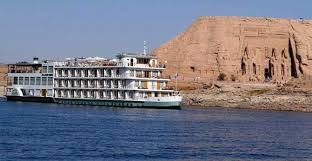
Importance of the Nile in Ancient Egypt
The Nile River, the lifeblood of ancient Egypt, played a pivotal role in shaping the civilization’s prosperity, culture, and daily life. As the longest river in the world, stretching over 6,600 kilometers (4,100 miles), the Nile provided fertile soil for agriculture through its annual inundation, facilitating the growth of crops such as wheat, barley, and flax. Its predictable flooding also enabled the development of a centralized government, as surplus food production allowed for the establishment of cities, trade networks, and monumental construction projects like the pyramids and temples.
Beyond its agricultural and economic significance, the Nile held immense spiritual and religious importance for the ancient Egyptians. They believed the river was a gift from the gods, with its annual flooding symbolizing the rejuvenation and renewal of life. Temples and shrines dedicated to deities such as Hapi, the god of the Nile flood, underscored the river’s divine status and its role in sustaining both mortal and immortal realms.
Popular Cruise Routes and Stops
Nile River cruises offer travelers a unique perspective on Egypt’s ancient wonders, combining leisurely voyages with visits to key archaeological sites and cultural landmarks. Popular routes typically include:
- Luxor to Aswan: This route traverses the heart of ancient Egypt, stopping at iconic sites such as the Karnak and Luxor Temples in Luxor, the Valley of the Kings, and the Temple of Kom Ombo dedicated to Sobek and Horus.
- Aswan to Abu Simbel: A less frequent but awe-inspiring route that culminates in a visit to the monumental temples of Abu Simbel, originally built by Ramses II and relocated during the construction of the Aswan High Dam.
- Cairo to Luxor: For those starting their journey in the capital, this route offers a blend of urban exploration in Cairo, including the Egyptian Museum and Giza Pyramids, before sailing south to Luxor.
Onboard Experiences and Amenities
Modern Nile River cruises combine comfort with cultural immersion, offering a range of onboard experiences and amenities. Travelers can expect luxurious accommodations, gourmet dining featuring both local and international cuisine, and entertainment options that often include traditional music and dance performances. Educational lectures by Egyptologists provide insights into the history and significance of the sites visited, enriching the cruise experience with scholarly perspectives.
Alexandria: Egypt’s Mediterranean Jewel
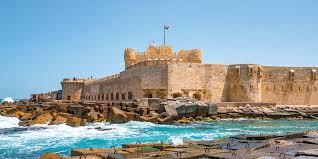
Alexandria: Bridging Ancient History with Modern Marvels
Historical Significance of Alexandria
Founded by Alexander the Great in 331 BCE, Alexandria quickly became a cultural and intellectual hub of the ancient world. Strategically located on the Mediterranean coast of Egypt, it served as a vital link between Egypt and the Greek world, blending Egyptian, Greek, and later Roman influences. Alexandria flourished as a center of learning and scholarship, boasting the Great Library and the Pharos Lighthouse, one of the Seven Wonders of the Ancient World. It was also a thriving commercial port, facilitating trade and cultural exchange across the Mediterranean.
Alexandria Library
The modern Bibliotheca Alexandrina, inaugurated in 2002, pays homage to the ancient Library of Alexandria, symbolizing Egypt’s commitment to intellectual pursuits and cultural revival. As a global center for knowledge and research, the library houses millions of books, manuscripts, and digital resources in various languages, supporting academic research, cultural programs, and exhibitions that promote cross-cultural dialogue and understanding.
Modern Architectural Marvel
Beyond its historical roots, modern Alexandria boasts architectural marvels that blend contemporary design with echoes of its ancient past. The Library of Alexandria, with its distinctive tilted roof resembling a sundial, stands as a beacon of modern Egyptian architecture. The Bibliotheca Alexandrina complex also includes the Planetarium Science Center and the Antiquities Museum, offering visitors a comprehensive experience of Alexandria’s cultural and scientific contributions.
Cultural Programs and Exhibitions
The Bibliotheca Alexandrina hosts a diverse array of cultural programs and exhibitions that celebrate Alexandria’s rich heritage and global connections. These include art exhibitions, literary festivals, concerts, and lectures by prominent scholars and artists from around the world. Special exhibitions often highlight Egypt’s archaeological treasures, contemporary art movements, and contributions to science and literature, fostering a vibrant cultural exchange between local and international audiences.
Catacombs of Kom el Shoqafa
The Catacombs of Kom el Shoqafa, dating back to the 2nd century CE, offer a fascinating glimpse into ancient burial practices in Alexandria. This necropolis, discovered in the early 20th century, combines Egyptian, Greek, and Roman architectural styles, reflecting Alexandria’s multicultural society during the Greco-Roman period. The catacombs feature intricate carvings, frescoes, and sculptural elements that depict religious motifs and scenes of daily life, providing insights into ancient beliefs surrounding death and the afterlife.
History of Burial Practices
The Catacombs of Kom el Shoqafa represent a unique blend of burial traditions, including Egyptian mummification practices, Greek funerary rites, and Roman architectural influences. The catacombs consist of multiple levels, accessed via spiral staircases, with burial chambers and niches carved into the rock. Tombs were often adorned with symbolic imagery and inscriptions that honored the deceased and ensured their journey to the afterlife.
Architectural Features
Architecturally, the Catacombs of Kom el Shoqafa exhibit a fusion of styles, characterized by Hellenistic columns, Egyptian motifs such as the winged sun disc (Horus), and Roman influences in the use of arches and vaults. The catacombs also include a central hall known as the Hall of Caracalla, named after the Roman emperor who visited Alexandria in the 3rd century CE. This hall served as a communal gathering space for mourning rituals and commemorations, reflecting the multicultural and cosmopolitan nature of ancient Alexandria.
Islamic and Coptic Heritage
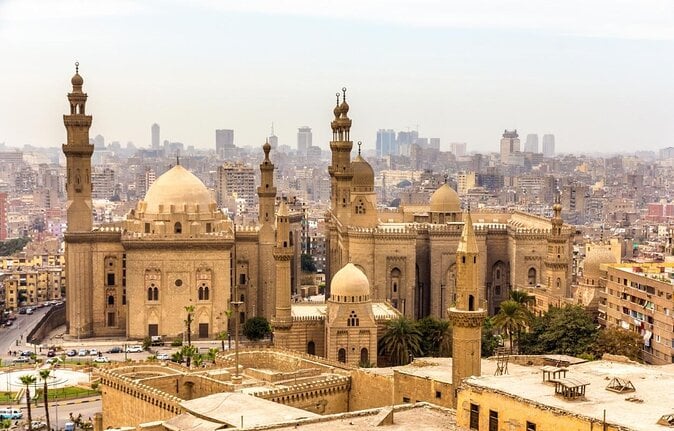
Islamic Cairo: A Tapestry of Faith and Commerce
Mosques and Religious Sites
Islamic Cairo, often referred to as Historic Cairo, is a vibrant district that encapsulates Egypt’s Islamic heritage and architectural splendor. Dating back to the 7th century CE, when Cairo was founded as the capital of the Islamic Fatimid Caliphate, this area is home to numerous mosques and religious sites that showcase the evolution of Islamic art and culture.
Prominent among these is the Mosque of Ibn Tulun, built in the 9th century and distinguished by its vast courtyard and unique spiral minaret, which offers panoramic views of the city. The Al-Azhar Mosque, founded in 970 CE, is renowned as one of the oldest universities in the world and remains a center of Islamic learning and scholarship. Its intricate Islamic architecture, including domes, minarets, and ornate woodwork, reflects centuries of cultural exchange and religious devotion.
Other notable sites include the Sultan Hassan Mosque and Madrasa, an architectural masterpiece known for its mammoth scale and exquisite Islamic decorations, and the Al-Hakim Mosque, revered by both Sunni and Shia Muslims for its historical significance and spiritual atmosphere.
Khan el-Khalili Bazaar
Nestled within the labyrinthine alleys of Islamic Cairo lies the Khan el-Khalili Bazaar, a bustling marketplace that has been a hub of commerce and culture for centuries. Founded in the 14th century during the Mamluk era, Khan el-Khalili remains one of the largest and oldest bazaars in the Middle East, where artisans, traders, and shoppers converge amid the scent of spices and the clamor of bargaining.
The bazaar’s narrow streets are lined with shops offering a dazzling array of goods, from intricate handmade jewelry and colorful textiles to traditional crafts such as copperware and brass lamps. Visitors can wander through centuries-old caravanserais and historic khans, traditional inns that once accommodated merchants and travelers along the ancient trade routes.
Beyond its commercial significance, Khan el-Khalili is a cultural treasure trove, where Egyptian hospitality meets centuries-old traditions. Cafes and restaurants offer a taste of local cuisine, while street performers and storytellers entertain passersby with tales of Cairo’s storied past. The bazaar’s enduring charm lies not only in its vibrant marketplace but also in its role as a living testament to Egypt’s rich cultural heritage and its enduring allure as a crossroads of civilizations.
Coptic Cairo
Churches and Monasteries
Coptic Cairo, also known as Old Cairo or Masr al-Qadima, is a historic district that serves as the heart of Egypt’s Coptic Christian community. Dating back to the early Christian era, this area is home to numerous churches, monasteries, and religious sites that reflect Egypt’s rich Christian heritage and the resilience of the Coptic Orthodox Church.
Prominent among these religious landmarks is the Hanging Church (Saint Virgin Mary’s Coptic Orthodox Church), a masterpiece of Coptic architecture dating to the 3rd century CE. Named for its location above the gatehouse of the Roman fortress of Babylon, the church’s wooden roof resembles Noah’s Ark, symbolizing salvation. Its interior is adorned with intricate icons, colorful murals, and marble columns, offering visitors a glimpse into the spiritual devotion and artistic achievements of Egypt’s Coptic community.
Other notable churches include the Church of Saint Sergius and Bacchus (Abu Serga), believed to be built atop the Holy Family’s resting place during their flight to Egypt. This ancient church, dating to the 4th century, features well-preserved Coptic art and architecture, including vaulted ceilings and sanctuary icons that depict biblical scenes and saints revered by Egypt’s early Christians.
Saint Sergius and Bacchus Church
The Church of Saint Sergius and Bacchus, also known as Abu Serga, holds special significance in Coptic Christianity as one of the oldest churches in Cairo and a focal point of pilgrimage. Tradition holds that the church marks the spot where the Holy Family, according to biblical accounts, sought refuge during their flight into Egypt. This association has made Saint Sergius and Bacchus Church a revered site for Coptic Christians and a testament to Egypt’s role in early Christian history.
The church’s architecture reflects a blend of Coptic, Byzantine, and Roman influences, with its nave, aisles, and sanctuary adorned with intricate carvings and vibrant frescoes depicting biblical scenes and saints. The sanctuary is centered around an altar believed to stand on the exact spot where the Holy Family rested, making it a place of deep spiritual significance and contemplation for visitors and worshippers alike.
Saint Sergius and Bacchus Church stands not only as a testament to Egypt’s enduring Christian faith but also as a beacon of cultural and religious tolerance in a region marked by diverse traditions and beliefs. Its preservation and ongoing use for worship underscore the continuity of Egypt’s Coptic heritage and its contribution to the tapestry of world Christianity.
Modern Egypt: Cairo and Beyond
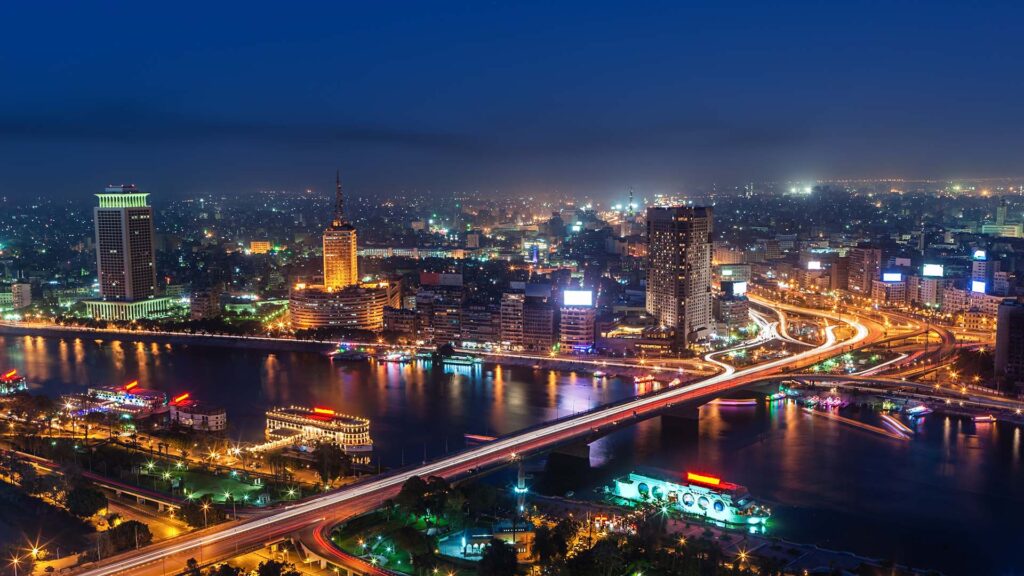
Modern Landmarks in Cairo
Cairo, a city steeped in history, has embraced modernity while preserving its historical charm. The Cairo Tower, an architectural marvel towering over the cityscape, offers panoramic views of the sprawling metropolis and the winding Nile River. Nearby, the Cairo Opera House stands as a cultural beacon, hosting international performances amidst contemporary Egyptian design. New Cairo, a burgeoning satellite city, exemplifies Egypt’s modern urban planning with its gleaming skyscrapers, luxury malls, and gated communities. These landmarks not only redefine Cairo’s skyline but also symbolize Egypt’s aspirations for economic growth and global connectivity.
Impact of Urbanization on Historical Sites
Urbanization in Egypt has brought both opportunities and challenges to its rich historical sites. As cities expand to accommodate growing populations and economic activities, historical sites face increasing pressure from development and infrastructure projects. The UNESCO World Heritage sites, such as the Pyramids of Giza and Luxor’s ancient temples, require careful preservation efforts amidst rapid urban growth. Conservation initiatives, supported by governmental and non-governmental organizations, aim to strike a balance between urban development and heritage conservation. The challenge lies in ensuring that Egypt’s historical legacy remains accessible and intact for future generations, while harnessing the economic benefits of urbanization responsibly.
Eco-Tourism and Desert Adventures
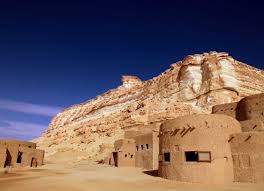
Modern Landmarks in Cairo
Cairo, a city steeped in history, has embraced modernity while preserving its historical charm. The Cairo Tower, an architectural marvel towering over the cityscape, offers panoramic views of the sprawling metropolis and the winding Nile River. Nearby, the Cairo Opera House stands as a cultural beacon, hosting international performances amidst contemporary Egyptian design. New Cairo, a burgeoning satellite city, exemplifies Egypt’s modern urban planning with its gleaming skyscrapers, luxury malls, and gated communities. These landmarks not only redefine Cairo’s skyline but also symbolize Egypt’s aspirations for economic growth and global connectivity.
Impact of Urbanization on Historical Sites
Urbanization in Egypt has brought both opportunities and challenges to its rich historical sites. As cities expand to accommodate growing populations and economic activities, historical sites face increasing pressure from development and infrastructure projects. The UNESCO World Heritage sites, such as the Pyramids of Giza and Luxor’s ancient temples, require careful preservation efforts amidst rapid urban growth. Conservation initiatives, supported by governmental and non-governmental organizations, aim to strike a balance between urban development and heritage conservation. The challenge lies in ensuring that Egypt’s historical legacy remains accessible and intact for future generations, while harnessing the economic benefits of urbanization responsibly.
Egyptian Cuisine and Cultural Experiences
Traditional Egyptian Dishes
Egyptian cuisine is a reflection of its diverse cultural heritage, blending ancient traditions with influences from Mediterranean and Middle Eastern cuisines. Ful medames, a staple dish dating back centuries, features slow-cooked fava beans seasoned with garlic, lemon, and olive oil, often served with fresh bread for breakfast. Koshari, a beloved street food, combines rice, lentils, pasta, and spicy tomato sauce, topped with crispy fried onions for a satisfying meal. Molokhia, a nutritious stew made from jute leaves and often paired with rice or bread, showcases Egypt’s agrarian roots along the Nile River. Desserts like baklava, layers of flaky pastry filled with nuts and sweetened with syrup, offer a delightful conclusion to any feast. Egyptian cuisine not only satisfies culinary cravings but also serves as a cultural bridge, preserving age-old recipes passed down through generations. Dining customs emphasize hospitality and communal sharing, with meals often enjoyed with family and friends. Street vendors and local eateries offer an authentic taste of Egyptian flavors, from savory falafel sandwiches to sweet pastries like basbousa and kunafa. Whether savoring a traditional dish at a bustling market or dining in a cozy family-run restaurant, exploring Egyptian cuisine is an essential part of experiencing the country’s rich cultural tapestry.
Cultural Shows and Performances
Egyptian cultural shows and performances offer a captivating glimpse into the country’s artistic heritage, blending ancient traditions with contemporary expressions. Traditional music and dance performances, such as the mesmerizing whirling dervishes and rhythmic tabla drumming, reflect Egypt’s diverse regional influences and historical legacy. Cairo’s cultural venues, like the Cairo Opera House and El Sawy Culture Wheel, host performances ranging from classical ballet and opera to modern Egyptian folk music and theatrical productions. Festivals like the Cairo International Film Festival showcase Egypt’s vibrant film industry and its contributions to global cinema. The annual Cairo Jazz Festival attracts musicians from around the world, highlighting Egypt’s role as a hub for cultural exchange and artistic innovation. Beyond music and theater, Egyptian cultural experiences include storytelling traditions, handicraft workshops, and exhibitions showcasing ancient artifacts and contemporary art. These cultural shows not only entertain but also educate audiences about Egypt’s rich cultural heritage and its enduring influence on the global stage.
Practical Travel Tips
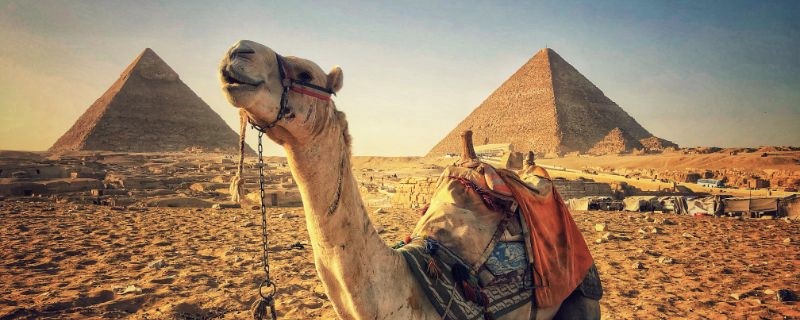
Best Times to Visit Egypt
The best times to visit Egypt are during the cooler months of the year, from October to April. During this period, temperatures are more moderate, making it ideal for exploring the country’s vast array of historical sites and natural wonders. In the winter months, from December to February, daytime temperatures in cities like Cairo and Luxor are pleasantly cool, ranging from 15°C to 25°C (59°F to 77°F). This is perfect weather for sightseeing, cruising the Nile, and exploring the deserts. Spring (March to April) and autumn (October to November) also offer comfortable temperatures and fewer crowds compared to the peak winter season. However, summer months (May to September) can be extremely hot, with temperatures soaring above 40°C (104°F), especially in the southern regions, which can make outdoor activities challenging.
Visa Requirements and Travel Logistics
When planning a trip to Egypt, understanding visa requirements and travel logistics is essential. Most travelers will need a visa to enter Egypt, which can be obtained either in advance from an Egyptian consulate or embassy, or upon arrival at major airports. The visa-on-arrival process is straightforward and usually grants a 30-day stay for tourism purposes. However, it’s advisable to check the latest requirements as they can vary based on your nationality. Online e-visas are also available and can be obtained before traveling, providing added convenience.
For travel logistics, Egypt is well-connected by international flights to major cities like Cairo, Alexandria, and Luxor. Domestic flights, trains, and buses offer efficient ways to travel between cities. Taxis and ride-sharing services are readily available in urban areas, while organized tours and private guides can enhance the experience of exploring historical sites. Currency exchange and ATMs are widely accessible, and credit cards are accepted in most hotels and restaurants. It’s also recommended to familiarize yourself with local customs and travel advisories to ensure a smooth journey.
Health and Safety Tips
Health and safety are paramount when traveling to Egypt. Before departure, ensure you are up to date on routine vaccines and consider additional vaccinations for hepatitis A, hepatitis B, typhoid, and rabies, depending on your travel itinerary. It’s advisable to carry a basic first aid kit and any prescription medications you may need, as well as over-the-counter remedies for common ailments like travelers’ diarrhea.
To stay safe, it’s important to drink bottled water and avoid ice in drinks, as tap water may not be safe for consumption. Exercise caution with street food, opting for freshly cooked items from reputable vendors. Staying hydrated and protecting yourself from the sun with hats, sunscreen, and light, breathable clothing is essential, especially during the hotter months.
In terms of security, it’s wise to stay informed about current travel advisories and avoid areas with political unrest. While major tourist destinations are generally safe, petty crime like pickpocketing can occur, so keep your belongings secure and be cautious in crowded areas. Using reputable tour operators and transportation services can enhance your safety and ensure a more enjoyable travel experience.
Conclusion
Egypt, with its unparalleled historical richness, offers an immersive journey through time, from the awe-inspiring pyramids of Giza and the ancient temples of Luxor to the vibrant cultural life of modern Cairo. The country’s blend of millennia-old heritage and contemporary vitality creates a unique tapestry that invites exploration. Experiencing Egypt’s history firsthand allows travelers to connect deeply with the cradle of civilization, walking the same paths as pharaohs, marveling at timeless monuments, and savoring the enduring traditions that have shaped the world. This profound connection to the past, coupled with Egypt’s warm hospitality, makes it an unforgettable destination for any history enthusiast.
FAQs about Historical Tours in Egypt
What are the Best Historical Sites for First-Time Visitors?
For first-time visitors to Egypt, several historical sites are essential to truly appreciate the country’s rich heritage. The Pyramids of Giza, home to the Great Pyramid and the Sphinx, are a must-see, offering a glimpse into the engineering marvels of ancient Egypt. In Cairo, the Egyptian Museum houses a vast collection of artifacts, including the treasures of Tutankhamun. Luxor, often referred to as the world’s greatest open-air museum, features the temples of Karnak and Luxor, as well as the Valley of the Kings, where the tombs of pharaohs like Tutankhamun and Ramses II can be explored. For a more comprehensive experience, a visit to Abu Simbel, with its colossal statues of Ramses II, and the temples of Philae and Kom Ombo along the Nile, provide deeper insights into Egypt’s ancient civilization.
How Can I Ensure a Safe and Enjoyable Trip to Egypt?
To ensure a safe and enjoyable trip to Egypt, preparation is key. Start by checking the latest travel advisories and health recommendations for vaccinations and necessary medications. When in Egypt, always drink bottled water and avoid ice made from tap water to prevent illness. Opt for reputable tour operators and guides, who can provide not only a richer understanding of the historical sites but also ensure your safety. Be mindful of your belongings, especially in crowded areas, to avoid petty theft. Dress modestly, respecting local customs, particularly when visiting religious sites. Stay hydrated and protect yourself from the sun with hats, sunscreen, and lightweight clothing. Finally, familiarize yourself with basic Arabic phrases or have a translation app handy, as this can enhance your interactions and experiences with locals.
What are Some Unique Experiences Available on Historical Tours?
Historical tours in Egypt offer a range of unique experiences that go beyond traditional sightseeing. One such experience is a hot air balloon ride over Luxor at dawn, providing breathtaking views of the Nile River, ancient temples, and the Valley of the Kings. For a more immersive adventure, consider a Nile River cruise, which allows you to explore multiple historical sites along the riverbanks while enjoying the scenic journey. Another unique activity is participating in an archaeological dig, where travelers can join experts in uncovering ancient artifacts. Nighttime sound and light shows at the Pyramids of Giza and Karnak Temple offer a dramatic retelling of Egypt’s history, bringing the ancient monuments to life through projections and narration. Additionally, visiting a local market or bazaar, such as Cairo’s Khan El Khalili, offers a vibrant glimpse into Egypt’s contemporary culture intertwined with its historical roots.


